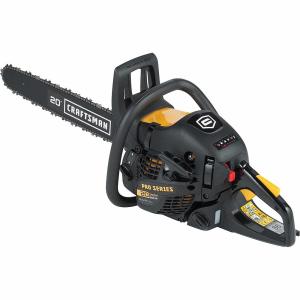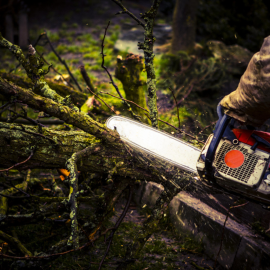How to store a chainsaw between seasons


When it's time to take a break from sawing logs and put away the chainsaw for a month or more, take a few minutes to prepare it. Your owner's manual covers specifics for your chainsaw model; here are typical steps for storing a chainsaw.
If you find any damaged or worn parts while winterizing the chainsaw, see our chainsaw DIY repair section for guidance.
Let the engine cool.
If there's still gas in the tank, drain the fuel from the gas tank, gas lines, carburetor and line connectors. You can instead add fuel stabilizer to the gas tank to prevent the fuel from forming gum deposits; run the saw for 3 minutes after adding, to spread the stabilizer through the fuel system.
Remove the chain and bar from the engine drive assembly. Clean all dirt, wood chips and grime from the drive gears, chain bar and chain. Clean wood chips, oil, grease, grime and debris from the chain drive gear and bar connection area. Now is a good time to sharpen the chain or install a new one. After reassembling the chain bar and chain, adjust the chain tension so the chain snaps into place after you pull it slightly away from the bar.
Oil the chain and wrap it in heavy paper or cloth. Lightly oil external metal surfaced and the guide part to prevent rust.
Remove the air breather and clean it according to the instructions in your owner’s manual. Most breathers can be washed in soapy water and then blown dry with compressed air.
Remove the spark plug and pour 1 teaspoon of 2-cycle engine oil into the spark plug opening. Slowly pull the starter rope 8 to 10 times to distribute the oil. Replace the spark plug with the type recommended in the owner's manual, gapped as recommended.
Inspect the old spark plug; a sticky or sooty electrode indicates incomplete combustion of the fuel, which could be caused by and incorrect fuel/oil mixture or spark plug gap setting.
Clean the air filter.
Tighten any loose screws, nuts and bolts.
Store the chainsaw in a clean storage case in a dry, dust-free place that's out of the reach of children.
Symptoms for gas chainsaws
Choose a symptom to see related chainsaw repairs.
Main causes: cracked fuel lines, leaky carburetor seals, damaged fuel tank cap, cracked fuel tank...
Main causes: bad gas, engine needs tune up, cracked fuel lines, dirty carburetor...
Main causes: stale gasoline, cracked fuel lines, dirty carburetor, damaged spark plug, worn piston rings...
Repair guides for gas chainsaws
These step-by-step repair guides will help you safely fix what’s broken on your chainsaw.

How to rebuild a chainsaw carburetor
If your chainsaw isn't running well, a dirty carburetor could be the problem. You can take it apart, clean it and rebuil...

How to replace a chainsaw carburetor
If the engine won't start even though there's fuel in the chainsaw, the carburetor could be the problem. Sometimes, it's...

How to replace chainsaw fuel lines
The fuel line on a chainsaw becomes brittle over time and can crack. Replacing it doesn't require a lot of DYI experienc...
Articles and videos for gas chainsaws
Use the advice and tips in these articles and videos to get the most out of your chainsaw.

Learn about all the convenient features on our Sears PartsDirect website that make your parts purchases easier....

Get answers to frequently asked questions about Sears and Sears PartsDirect....

Learn the basics of taking care of your chainsaw and solving common problems....